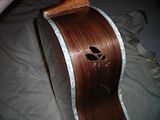
For what it's worth, the soundport dimensions seem too small to make any difference. The soundport on my first build (above) is barely noticable. I strung it up yesterday and forgot to even hear the difference it made. When I did remember that detail I had someone put their hand over it for comparison when I was playing and the port does make the sound a tiny bit fuller, but to my untrained ear it is not as much difference as I thought it would be. I think it's smaller than most soundports though.
Looking at your pic (cool design btw! I like it!) the two larger holes look as if they'd make a 4" diameter hole when put together. I don't know what the soundhole dimensions are usually on a lap guitar and I'm sure you don't need a reminder but...
Alan Carruth from acousticguitarforum wrote:
The relationship between the soundhole size and the body volume more or less sets up the pitch of the 'Helmholtz' resonance. This is what you hear when you blow across the mouth of a wine bottle. There's a 'piston' of air in the neck of the bottle that bounces on a 'spring' of air inside, and the pitch is set by the relationship between the mass and the spring. If you decrease the volume in the bottle, the pressure changes more for a given motion of the piston, the spring gets stonger, and the pitch goes up. If you make the neck shorter the weight of the piston drops, and the pitch rises. If you increase the diameter of the neck the pitch also rises.
The problem for us is that the guitar body is not like a bottle: it has flexible walls. The top, in particular, pumps air in and out through the soundhole as it moves, and the pressure changes due to air flowing through the hole also push on the top. Thus the air and top have to work togehter, in what's called a 'bass reflex couple'. This results in two low frequency resonances: a 'main air' mode that looks like the Helmholtz mode, and a 'main top' mode where the lower bout is moving in and out like a loudspeaker cone. If you calculated the Helmholtz pitch on the basis of the soundhole size and box volume, you'd find that the 'main air' mode is lower in pitch. Similarly, the 'main top' mode frequency is shifted upward from what it would be by the interaction with the air. The degree of the frequency shift is a measure of how strongly the two are coupled.
Making the box deeper has two effects on the 'main air' mode: the extra mass of air for the same size hole tends to drop the Helmholtz pitch, as you'd expect. However, with a deeper box any given amount of top motion causes less of a pressure change inside, so the 'couple' is weaker, and the downward shift of the 'main air' pitch from the expected 'Helmholtz' frequency is less. It turns out that in practice the two pretty well cancel out, if you don't go too wild with the depth change. Fred Dickens made a guitar about 6" deep years ago, and cut it down progressivly to about 3" or less, iirc, and the 'main air' pitch rose by (drumroll) 7%: not much more than a semitone.
What does happen is that, since the top isn't changing the pressure in the box as much, there's less air being moved through the soundhole, so the 'main air' peak in the spectrum gets weaker. Usually the sound gets 'smoother' or 'rounder' in the bass.
Enlarging the hole does two things: it raises the 'main air' pitch, and makes the resonance stronger. The pitch rise would tend to make the sound less bassy, an the added power would tend to make it more bassy, so it all comes down the the exact balance in the particular case.



